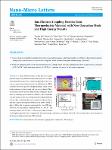Item Infomation
Full metadata record
| DC Field | Value | Language |
|---|---|---|
| dc.contributor.author | Yongjie, He | - |
| dc.contributor.author | Shaowei, Li | - |
| dc.contributor.author | Rui, Chen | - |
| dc.date.accessioned | 2023-04-19T07:27:32Z | - |
| dc.date.available | 2023-04-19T07:27:32Z | - |
| dc.date.issued | 2023 | - |
| dc.identifier.uri | https://link.springer.com/article/10.1007/s40820-023-01077-7 | - |
| dc.identifier.uri | https://dlib.phenikaa-uni.edu.vn/handle/PNK/8088 | - |
| dc.description | CC BY | vi |
| dc.description.abstract | Ionic thermoelectrics (i-TE) possesses great potential in powering distributed electronics because it can generate thermopower up to tens of millivolts per Kelvin. However, as ions cannot enter external circuit, the utilization of i-TE is currently based on capacitive charge/discharge, which results in discontinuous working mode and low energy density. Here, we introduce an ion–electron thermoelectric synergistic (IETS) effect by utilizing an ion–electron conductor. Electrons/holes can drift under the electric field generated by thermodiffusion of ions, thus converting the ionic current into electrical current that can pass through the external circuit. | vi |
| dc.language.iso | vi | vi |
| dc.publisher | Springer | vi |
| dc.subject | Ionic thermoelectrics | vi |
| dc.subject | IETS | vi |
| dc.title | Ion–Electron Coupling Enables Ionic Thermoelectric Material with New Operation Mode and High Energy Density | vi |
| dc.type | Book | vi |
| Appears in Collections | ||
| OER - Kỹ thuật điện; Điện tử - Viễn thông | ||
Files in This Item:

